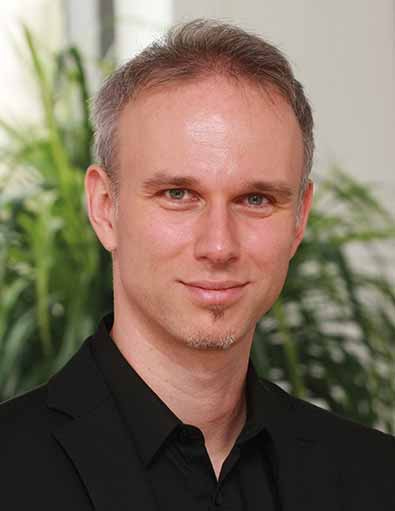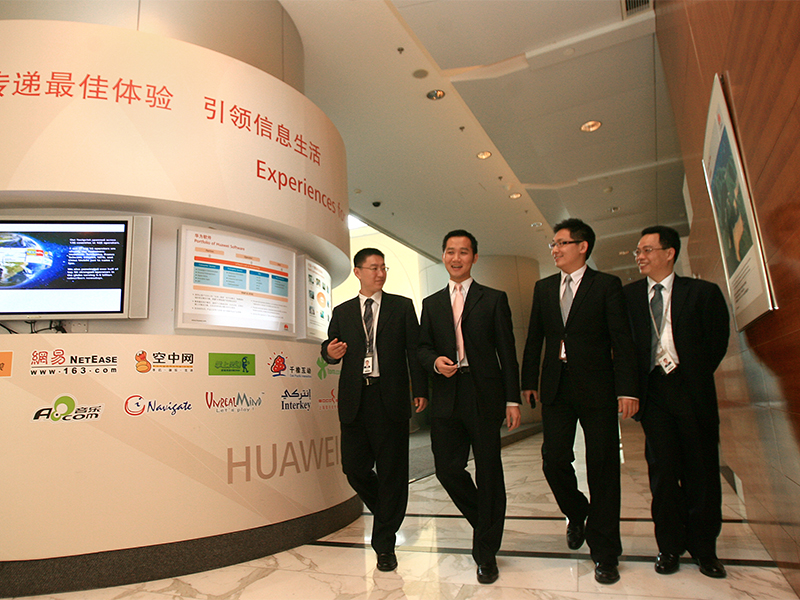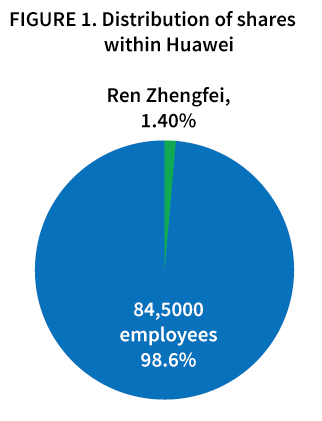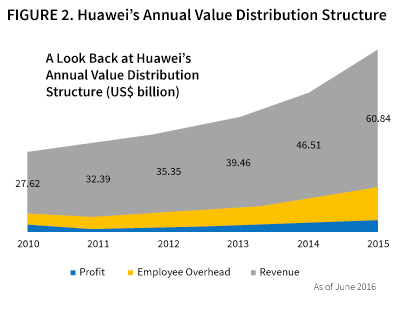By David De Cremer and Tian Tao
If organisations are serious in building cultures that can translate the desire to create joint value into a competitive advantage, it is needed that they become architects of systems that account for the human nature of its employees. One company that has become known to implement experimental approaches based on insights on how human nature works is the Chinese telecom giant Huawei.
Although effective organisations that create joint value combined with a long-term view are predicted to be the future model, they are still considered to be a rarity. A contemporary problem is that all too often performance systems are focused on achieving results with not enough attention to the human aspects of the work that influence the effectiveness of the system itself. Indeed, performance is still believed to improve by employing systems that are tailor-made on the assumption that rational actors populate organisations. As a result, the influence of emotions, irrationalities and psychological forces at large are discounted when designing these organisational systems. Research on human decision making flaws have identified very clearly now that the idea of rational man is an illusion and that organisations continuing to treat their most important asset – humans – in ways that do not accommodate their irrationalities will not go far.
Despite the rise of automation processes and the use of robots, people are still at the heart of organisations. Organisations nevertheless base their management processes, systems and even HR policies on outdated ideas of human behaviour and organisational design. This is a serious limitation to the capacity of any organisation trying to balance improving productivity and at the same time keeping their employees satisfied and motivated. What is needed is that HR managers and organisational leaders adopt an attitude to design systems that are based on the best understanding of human nature. This kind of attitude requires that organisations consider themselves to be architects of organisational designs that fit human needs and irrationalities. Relying on the best insights on what motivates people and what the irrational biases may be underlying their pursuit of those desires will allow organisations to design systems that are not only more effective in getting the best out of people but also reduce costs on the long term significantly. At the end of the day, organisations with such an architect mindset will be able to create more joint value for all of their stakeholders (society, customers and employees).
An important problem that prevents most companies to adopt this strategy and foster an architect mindset concerns the fact that experimenting and learning about the beneficial impacts of human nature on organisational design requires short-term losses to achieve long-term gains. Because of the pressure of many companies to satisfy and meet the requirements of their shareholders, this trade-off is hard to achieve. As a result, we see less experimentation based on sound reasoning happening. One company that does not face the pressures of public shareholders and consequently has become known to implement experimental approaches based on insights on how human nature works is the Chinese telecom giant Huawei. The company is a leading global information and communication technology (ICT) provider that was founded in 1987 in Shenzhen, by Ren Zhengfei. Today it employs more than 170 000 staff and serves more than 3 billion customers worldwide. It is the only Chinese company that receives more sales revenue from markets outside (67%) than from inside China. In the fiscal year of 2015 Huawei´s revenue reached CNY395 billion (US$60.8 billion) and CNY36.910 billion (US$5.68 billion) in net profit.
A feature relevant to the purpose of the present article is that Huawei is an employee-owned company facing no pressures from any private investors. This allows the company to develop long-term strategies and engage in thoughtful reflections on the business models Huawei will employ. It is an understatement to say that Huawei breeds an intellectual climate fostering thoughts and ideas about a wide variety of business challenges. In fact, Ren Zhengfei is repeatedly quoted as saying that the most important thing to value is the power to think. It is the belief of the company that innovation without a solid academic foundation is never going to be big business. It is just messing with the details. Ren Zhengfei has the belief that the Internet age has created a generation of inflated ideas in China’s young people and therefore fears that serious scientific research is lacking these days. The only way to achieve great leadership is therefore to do some hard learning and this idea has become a mission for all of Huawei employees.
So, how has this intellectual look at business challenges resulted in Huawei’s experimentation with human nature with the aim to promote organisational effectiveness? We identify three important experiments that have and are defining Huawei as the company it has become today. Each of these three behavioural-based interventions are derived from insights into the drives of humans and their corresponding biases.
[ms-protect-content id=”9932″]Intervention 1: Being Employee-owned as a way to distribute power
Huawei is an employee-owned company because it uses the self-designed Employee Stock Ownership Plan (ESOP). In this ESOP, Ren Zhengfei holds 1.4% of the company’s total share capital whereas around 84,000 employees hold the rest of the shares (see Figure 1). This employee shareholding system is referred to within Huawei as the “silver handcuff” system, which is different from the more common stock option arrangement, which is usually termed the “golden handcuff”.
The idea of employees owning the company is something that has only recently received serious attention in the West. Indeed, building on the observation that wealth inequalities are damaging productivity and feelings of ownership of employees, Hillary Clinton, for example, argued in her race for the US presidency that the time is there that companies have to offer profit-sharing plans to their employees. Clinton noted that in order to increase productivity wages have to go up and to achieve this companies have to allow employees to benefit from the profits that companies make – an idea that basically encourages companies to implement a structure that allows employees to own (at least partly) the company.
The reason why Huawei has initiated such a unique system has to do with their idea that people are motivated to secure financial security and in order to achieve that security they are willing to perform. Of course, Huawei does not want their employees to become focused on the financial value only. Turning employees into capitalists without a concern of the broader and organisational context will deteriorate on the long term the quality and prosperity of the company. Therefore, Huawei adds to the idea that employees share in the profits also the notion that they want their employees to perform in responsible ways. A sense of responsibility is achieved by making employees co-owners, accountable for both inputs as consequences. As the financial crisis has shown, pursuing financial gains but then with the money of someone else does not breed responsible behaviour. In this set-up the employees are working for and with their own welfare.
The underlying message is that distributing wealth will create joint value that will unite efforts and long-term success. As the Chinese saying goes: “If you distribute wealth, people will come together, if you keep the wealth, people will be isolated.” In line with this idea, in 2015, Huawei spent 23.6% of their revenue to salaries and bonuses (a total of $14.85 billion), whereas the average number in the industry is about 12% (see Figure 2 for a visual demonstration of the increasing use of revenue for employee overhead).
Important to note is that this act of distributing wealth goes together with a specific interpretation of what power means. As a matter of fact, turning your company into an employee-owned one makes that power is redistributed in such a way that the bosses cannot influence the employees anymore in ways they would like to see. This consequence is very much reflected in Ren Zhengfei’s suggestion that employees should turn their eyes to the customers and turn their back to the bosses. Huawei – being a customer-focused company – thus wants to create a culture in which employees are willing to work harder to better serve the customer and in doing that are willing to take up their responsibilities to achieve this result themselves without their bosses. It is a sense of pride and ownership that will make a company sustainable and nevertheless fast moving. Huawei as such defines power more in terms of the desire of employees to gain freedom to perform better. This perspective on power is different from the one that most companies use. In fact, most organisations still stick to the old idea that power corrupts because they see power as having the ability to control others. Recent behavioural research, however, has illustrated that people, in general, want to be in charge because it offers freedom, not because it allows people to control others. This idea of power to have more freedom to excel brings us to a second behaviour-based intervention of Huawei.
Intervention 2: Creating freedom to excel
At Huawei, 1 out of 2 employees are engineers and therefore involved with some aspect of R&D. They are knowledge workers and one very typical feature of this kind of workforce is that they want freedom in how they do their job. In fact, places that rely on human capital – which creative sectors do – display wise leadership if they provide their employees a measure of freedom. Wise leadership is what Ren Zhengfei has been attributed to. The story goes that Ren was so impressed by the AT&T Bell labs in the early years of Huawei that he used it to model his thinking on how research should be done. Although AT&T Bell labs gradually departed from their curiosity driven research climate after the break-up of AT&T, Huawei made it one of their corner stones, relying on the innate desire of human intellectuals to work with freedom.
Providing this freedom also has its limitations and it is one of the reasons why so many companies have problems installing systems that rely on promoting the autonomy of their workforce. An important limitation is the fact that the human motive to value freedom and autonomy of actions goes together with the irrational tendency to avoid irreversible decisions. Specifically, if striving for freedom is the dominant motive people will feel less compelled to commit to anything, anyone or any choice – as they wish to preserve their freedom. A result of this is that people will choose often the least risky choice or even stick to the status quo. Of course, knowledge workers are expected to deliver the newest and brightest ideas around and this goal implies that risks are being taken and commitment is shown to taking unknown paths. To counteract this irrational human tendency, it is necessary that the architects of organisational designs create conditions under which this fear of risk and change is overruled. One way to do this is to ensure that failure in their search for creative solutions is allowed and not used against them. In other words, create a system that tolerates failure and includes it in their feedback loop to enhance learning. This brings us to the third-behaviour based intervention.
Intervention 3: Failing to innovate
In the ICT industry innovation is a key issue. For that reason companies invest considerable amounts in R&D. Huawei’s investments have always been above 10% of their revenue and plan to double those investments in the next 30 years. What is specific about Huawei’s approach is that they want to foster the development of creative ideas and implementation of innovation itself in the purest form possible. Therefore, in line with their intellectual climate they use 30% of their R&D investments for fundamental scientific research. Furthermore, to counteract the inefficiencies of intellectual freedom – as discussed under intervention 2 – Huawei has agreed with a policy that of this 30% investment failure in 50% of the projects will be accepted. This decision as such removes the human tendency to avoid commitment to risky choices and reverses it by motivating their knowledge workers to take paths unknown.
By contributing such large amounts of revenues with the aim to foster curiosity-driven research climates the company takes risks, but by doing this signal in an unambiguous way to their employees that their mission to connect people by means of their inventions is something to be proud of. Despite the behavioural-based approach of this intervention, many organisations nowadays do shy away from accepting failure in such blatant ways. Why?
Organisations do not like failure for several reasons. A first reason concerns the negative impact it may reveal on the reputation of the company. Blinded by a desire to see only growth, public companies face the challenge not to disappoint their external shareholders. Any signal that failures occur imposes quickly fear that short-term costs will be high, making that such news is hardly ever communicated. As a result, we see many companies that install cultures where not accepting failure becomes the norm, and those failures that do occur will go underground and stay there until they explode and cause much more harm to the company on the long term. A second reason has to do with the irrational phenomenon called the “illusion of control”. Feeling in control is a valuable business asset because it increases confidence that our business plans and forecasts are worth pursuing. Control as such has been elevated to the highest goods in the corporate world as a whole. The problem, however, is that this kind of culture makes people believe that they control situations that are actually determined by chance, hence, the idea of the illusion of control. A third reason for not willing to consider failures has to do with the irrational tendency that we call input bias. This bias refers to the tendency of people to use signs and evidence of effort to evaluate the outcomes that are achieved. In other words, we like to use the simple belief that any effort will produce something and as such can be judged and rewarded. Of course, if efforts lead to failures when pursuing innovation, it is difficult on the short term to judge the value of those efforts as a successful outcome is missing. Because of these reasons; it is crucial for organisational architects to come up with systems that will remove the emergence of these biases to promote the higher goal – in this case being creative without the fear to fail.
To conclude, if organisations are serious in building cultures that can translate the desire to create joint value into a competitive advantage it is needed that organisations become architects of systems that account for the human nature of its employees. It is therefore necessary that the latest behavioural insights are used to build cultures that use the human potential available in the best way possible and at the same time design corrective systems that can prevent or neutralise the emergence of irrational biases undermining the long-term value of this exact potential.
[/ms-protect-content]
About the Authors
 David De Cremer is the KPMG professor of management studies at the Judge Business School, University of Cambridge, UK, and a fellow of the Ruihua Innovative Management Research Institute at Zehjiang University, China. He is the head of the department of Organisational Leadership and Decision-Making at Judge Business School and was currently named one of the 2016 Global Thought Leaders on Trust. Before moving to the UK, he was a professor of management at China Europe International Business School in Shanghai. He is the author of the book Pro-active Leadership: How to overcome procrastination and be a bold decision-maker (2013) and his new book – together with Tian Tao – Huawei: Leadership, culture and connectivity will be out in print early 2017.
David De Cremer is the KPMG professor of management studies at the Judge Business School, University of Cambridge, UK, and a fellow of the Ruihua Innovative Management Research Institute at Zehjiang University, China. He is the head of the department of Organisational Leadership and Decision-Making at Judge Business School and was currently named one of the 2016 Global Thought Leaders on Trust. Before moving to the UK, he was a professor of management at China Europe International Business School in Shanghai. He is the author of the book Pro-active Leadership: How to overcome procrastination and be a bold decision-maker (2013) and his new book – together with Tian Tao – Huawei: Leadership, culture and connectivity will be out in print early 2017.
 Tian Tao is codirector of Ruihua Innovative Management Research Institute at Zehjiang University. He is the founder and Editor in Chief of Top Capital magazine and his newest book Huawei: Leadership, culture and connectivity will be out in print early 2017.
Tian Tao is codirector of Ruihua Innovative Management Research Institute at Zehjiang University. He is the founder and Editor in Chief of Top Capital magazine and his newest book Huawei: Leadership, culture and connectivity will be out in print early 2017.





































